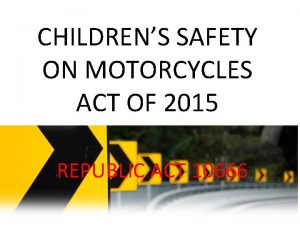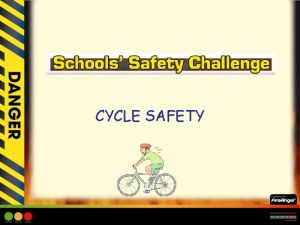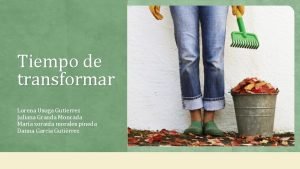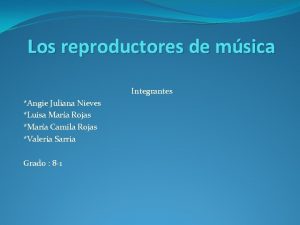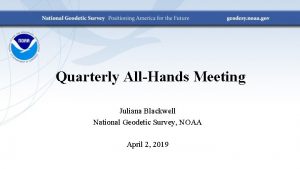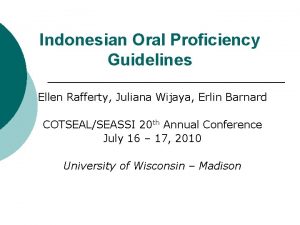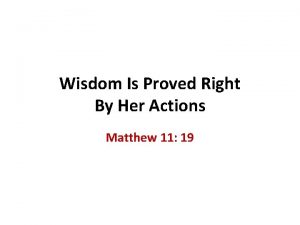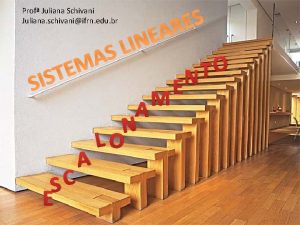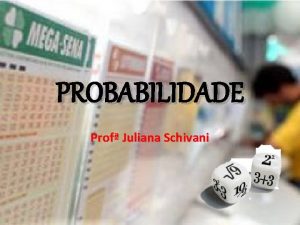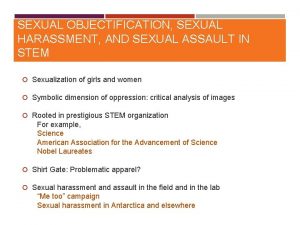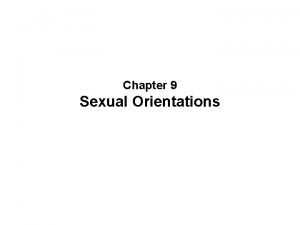Creating Sexual Safety for All Children Juliana Menke
















































- Slides: 48

Creating Sexual Safety for All Children Juliana Menke, MS, LMHC

Our Starting Point Girls – 1 in 4 Boys – 1 in 6 20% under the age of eight 40% are molested by an older, bigger or stronger child 93% know and trust the abuser (and their parents know and trust the abuser, as well) How can we add layers of protection?

What is Child Sexual Abuse? Rape Oral contact Fondling Exposure Showing pornography

The Three Keys Knowing Red Flag Behaviors The Gut Instinct How to Take Action

Learning Red Flag Behaviors Child molesters use specific behaviors. Any person can learn to recognize these red flag behaviors.

Red Flag #1 Alone Time Adults and older children who seek out ALONE TIME with children. More than 80% of sexual abuse cases occur in one-adult (or older child)/onechild situations.

If You Allow Alone Time… Ask about planned activities. Ask the adult how things went. Ask your child for the same information.

If You Allow Alone Time… Drop in unexpectedly, and often. Make sure outings are observable. Even a trip to the bathroom at the park can create alone time.

Red Flag #2 Secrets Adults and older children who teach children to KEEP SECRETS from parents and guardians. SECRECY is essential to child molesters.

No Secrets…Only Surprises A child molester MUST create a secret with a child. So…use SURPRISE instead… Why? Explain the difference. Explain why to anyone who asks. Take extra time with the older generation.

Red Flag #3 Abuse of Position and Power Avoid giving responsibility of a child’s safety, BASED ON POSITION OR POWER ALONE. Ex: Dr. Earl Bradley

Red Flag #4 Privilege and Protection of Program Privilege-seeing oneself as outside the law, due to one’s program Protection-shielding individuals in a program from responsibility Ex: Steubenville, OH; Jerry Sandusky & Penn State

Privilege & Protection Culture of program reverence Avoidance of bad publicity about program Conscious decision of program leaders to hide the truth

Steps for In-The-Moment Response § Always stay calm and be pleasant. § Interrupt. § Describe. § Explain the needed change. § Say thank you. § If needed, wait for the change to take place.

Red Flag #5 Ignoring Physical Boundaries Adults and older children who IGNORE PHYSICAL BOUNDARIES with children. The first physical contact is commonly nonsexual in nature

Example Say, “I saw Ben pulling away when you were touching his hair. ” Say, “Our family rule is that Ben has a right to not be touched, if he doesn’t want to be touched. ” Say, “Thank you for honoring our family rule by letting Ben move away from you when he wishes. ”

Red Flag #6 Grooming (Singling Out) Adults and older children who SINGLE OUT/GROOM a child by providing gifts, trips, money and other “special” things. Child molesters use coercion, manipulation and seduction gain access to a child.

Example Say, “Mary told me that you gave her a pair of Nikes today. ” Say, “In our family, money and gifts to children need the parent’s preapproval. ” Say, “Thank you for checking with me or her Dad in advance before offering her any gifts or money. ”

Red Flag #7 Sexualizing Children Adults and older children who SEXUALIZE children. They describe children with sexual language (i. e. sexy, stud). They encourage “sexiness” in children’s behavior (dancing, attire, e. g. )

Example Say, “I heard you call Sarah a sexy girl. ” Say, “Our family does not use adult language to describe a child. ” Say, “Thank you using different words to describe Sarah – such as kind, sweet, or smart. ”

Red Flag #8 Blurring Specific Roles Adults and older children who are BLURRING SPECIFIC ROLES. Ex: Debra La. Fave, Stephanie Ragusa

Example Say, “Alex tells me you offered to drive him to the mall. ” Say, “We need you to clear that kind of invitation with me or his Mom first – before you talk with him. ” Say, “Thank you for always checking in advance from now on. ”

The Gut Instinct Listen to your gut instinct, then… Test your instinct, by…reviewing the red flag behaviors, with a trusted and informed friend or family member.

Child-On-Child Concerns The power differential Size, Age and Strength The knowledge differential Emotional and Intellectual Impulsivity Lack of Safety Information

The Life-Long Conversation Open a life-long conversation with children about healthy sexuality Be calm – Be ready! Parents and guardians, become the goto person about healthy sexuality. (Words on the next page)

Language Use the accurate scientific terms for body parts, from infancy. For girls: vagina, vulva and breasts For boys: penis, scrotum and testicles For both: anus

Understand Normal Sexual Development Curiosity & Exploration Normal is what they figure out on their own Answer the question – or find the answer… It is okay to say “I don’t know, but we’ll find out together. ”

Responding Wisely Do not allow inappropriate sexual exploration or play, such as… Simulating sex Touching outside or inside clothing Using force to touch another child’s genitals outside of their clothing

Responding Wisely, continued Be careful not to over-react. Children often imitate something they have seen another person do – on TV, in a movie, on a computer, in person… Calmly tell them to stop – then explain appropriate behavior.

Responding Wisely, continued If you are not sure about a behavior… Or, if a child seems unable to gain control of themselves… Or a child changes their behavior, but cannot hold their change, then… Contact your pediatrician or a child therapist.

Teaching Children To Say “No” There are times when a child should say ‘No” to an adult. Children who never get any practice saying “No, ” are vulnerable to obeying a child molester. Help children practice saying “No” to the safe people in their lives.

Teaching Children Boundaries Teach children not to touch others who say “No” to them. Respect for boundaries is a two-way street. Honor your child’s boundaries. If a child resists contact with a specific adult, honor this.

Extra Safety Points Teaching Discernment Computer and Video Games Pornography Use of Drugs and Alcohol

Responding to a Child’s Disclosure If a child discloses sexual abuse – stay calm! Say “You did the right thing to tell me. ” Say “I’m going to get you some help. ” Say “It was not your fault. ” Stop at this point, and get the help (call 911)

Trainings for Children are best “trained” by informed and prepared parents, guardians and caregivers. Most school information starts around fifth grade. Kids need safety information far sooner than puberty and well before fifth grade.

Preventing Abduction When a child is abducted, they are almost always alone. Safety goes up dramatically in groups with adult supervision. “Safe” neighborhoods can always be entered by dangerous people. Familiarity does NOT create safety.

Adding that layer of protection Please take and use whatever you have found to be helpful Leave the rest for another time Thank you! Juliana Menke, MS, LMHC 327 -7656 X 4160

Web Sites for Child Sexual Safety Information darkness 2 light. org stopitnow. org

Web Site, Cont… Web Sites for Information on Human Sexuality teenwire. com plannedparenthood. org rutgers. edu/page/sexetc

Book List Illustrated books to read with young children about healthy human sexuality and private parts Where Did I Come From? Peter Mayle – Ages 6 and up What’s the Big Secret? Talking about Sex with Boys and Girls – Laurie Krasney Brown & Marc Brown (creator of the Arthur stories)

Book List, Cont… Books to read with girls about healthy human sexuality The Care & Keeping of You: The Body Book for Girls - Valorie Schaefer What’s Happening to My Body? For Girls– Lynda and Area Madaras My Body, My Self For Girls- Lynda and Area Madaras

Book List, Cont… Books to read with boys about healthy human sexuality What’s Happening to My Body? Book for Boys– Lynda and Area Madaras My Body, My Self for Boys- Lynda and Area Madaras The Boy's Body Book: Everything You Need to Know for Growing Up YOU - Kelli Dunham What’s Going On Down There? Karen Gravelle – Boys ages 6 and up

Book List, Cont… A series of books to read with children about healthy human sexuality It’s Not the Stork – Robie H. Harris – Ages 4 and up It’s So Amazing – Robie H. Harris – Ages 7 and up It’s Perfectly Normal – Robie H. Harris – Ages 10 and up

Book List, Cont. . Books for adults to read to guide them as they guide their children But How’d I Get In There In The First Place? Deborah M. Roffman Sex and Sensibility (A Thinking Parent’s Guide to Talking Sense About Sex) – Deborah M. Roffman From Diapers to Dating – Debra V. Haffner What Every 21 st Century Parent Needs To Know – Debra V. Haffner Beyond the Big Talk – Debra V. Haffner

Book List, Cont… Books for adults and teens to read together Changing Bodies, Changing Lives – Ruth Bell Free Your Mind: The Book for Gay, Lesbian, and Bisexual Youth and Their Allies, by Ellen Bass and Kate Kaufman All About Sex: A Family Resource on Sex and Sexuality, by Ronald Moglia and Jon Knowles

Book List, Cont… Books to read with children about healthy vs. unhealthy (secret) touches Your Body Belongs To You – Cornelia Spelman - Ages 0 -4 My Body Is Private – Linda Walvoord Girard - Ages 4 and up Who Will Teach Johnny the Difference Between Good Touches and Bad Touches? - Sandy West-Smith - Ages 4 and up. The Right Touch: A Read-Aloud Story to Help Prevent Child Sexual Abuse - Jody Bergsma Collection - Ages 4 and up A Touching Book – Jan Hindman - Ages 6 and up

Identifying Child Molesters Before They Strike - Quick Guide A child molester is… Someone who seems obsessed or preoccupied with your child. Someone who makes inappropriate comments about your child’s looks or body. Someone who insists on being physical with your child (hugging, kissing, tickling, wrestling) even when the child doesn't want this attention. Someone who has little or no boundaries and doesn't respect the Too helpful Too private Too attentive to children

Identifying Child Molesters Before They Strike - Quick Guide, Cont… Too touchy with children Too involved with image management Too one-sided in relationships (always giving and never taking) Too opportunistic Too superficial Too prone to violate boundaries of personal space and privacy Too aggressive when confronted Too quick to drop friendships when children grow older Too likely to disappear when contact with children is denied Too charming TOO GOOD TO BE TRUE
 Name all the lines
Name all the lines Sino ang di sakop ng republic act 10666
Sino ang di sakop ng republic act 10666 Cycle safety for children
Cycle safety for children Julianausugav
Julianausugav Juliana salas
Juliana salas Bso
Bso Juliana valencia montes
Juliana valencia montes Lotero juliana
Lotero juliana Juliana villegas restrepo
Juliana villegas restrepo Juliana casali xxx
Juliana casali xxx Königin juliana schule bonn
Königin juliana schule bonn Juliana nieves
Juliana nieves Olga boznanska
Olga boznanska Juliana montoya cardona
Juliana montoya cardona Juliana schivani
Juliana schivani Polinômio
Polinômio Julian tuwim ciekawostki dla dzieci
Julian tuwim ciekawostki dla dzieci Juliana schivani ifrn
Juliana schivani ifrn Juliana antero
Juliana antero Docente.ifrn.edu.br
Docente.ifrn.edu.br Juliana blackwell
Juliana blackwell Son las características de un polímero
Son las características de un polímero O que é dividendo matemática
O que é dividendo matemática Juliana blackwell
Juliana blackwell Julian tuwim życiorys dla dzieci
Julian tuwim życiorys dla dzieci Juliana truma
Juliana truma Juliana schivani
Juliana schivani Juliana schivani ifrn
Juliana schivani ifrn Mediana com frequencia
Mediana com frequencia Desvio padrão excel
Desvio padrão excel Golfhotel juliana
Golfhotel juliana Juliana daza
Juliana daza Dr. juliana wijaya
Dr. juliana wijaya Juliana casali edad
Juliana casali edad Arranjo analise combinatoria
Arranjo analise combinatoria Mariana polastre
Mariana polastre Wisdom is proved right by her actions
Wisdom is proved right by her actions All children can learn slogan
All children can learn slogan All children except one grow up
All children except one grow up It's the song of the redeemed
It's the song of the redeemed It's the song of the redeemed
It's the song of the redeemed Fspos vägledning för kontinuitetshantering
Fspos vägledning för kontinuitetshantering Novell typiska drag
Novell typiska drag Nationell inriktning för artificiell intelligens
Nationell inriktning för artificiell intelligens Returpilarna
Returpilarna Varför kallas perioden 1918-1939 för mellankrigstiden?
Varför kallas perioden 1918-1939 för mellankrigstiden? En lathund för arbete med kontinuitetshantering
En lathund för arbete med kontinuitetshantering Särskild löneskatt för pensionskostnader
Särskild löneskatt för pensionskostnader Tidböcker
Tidböcker

